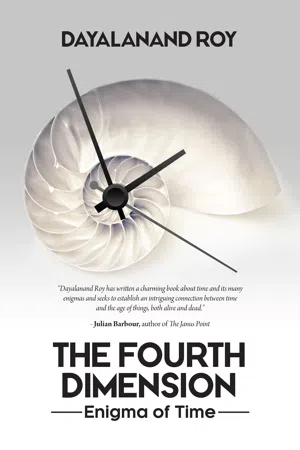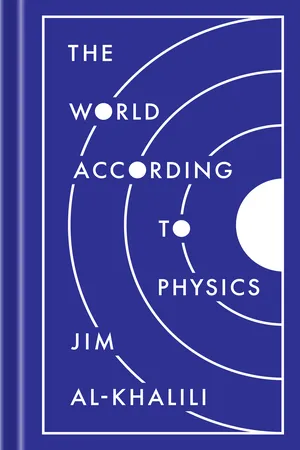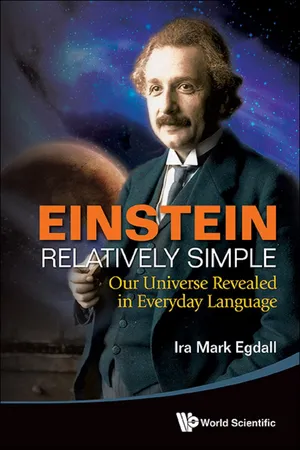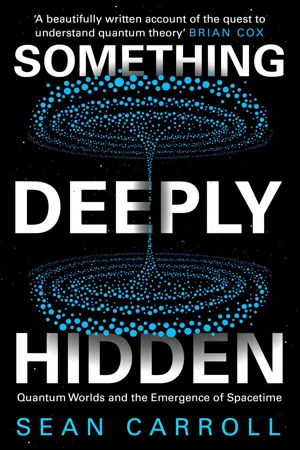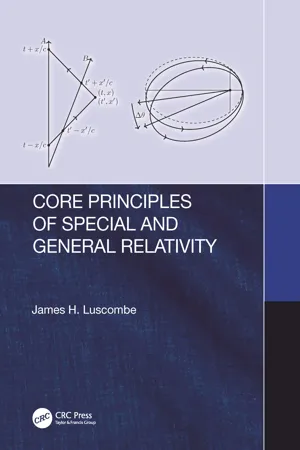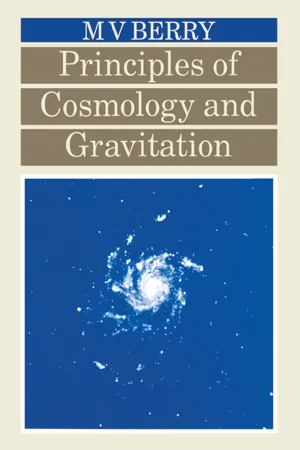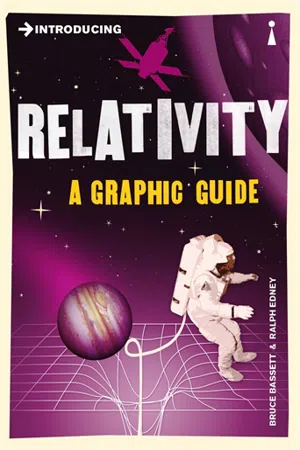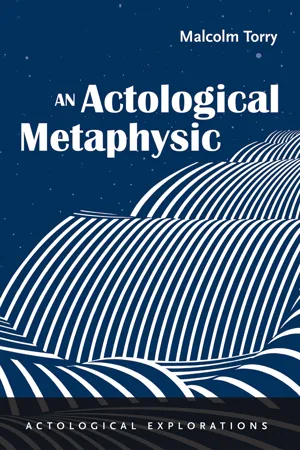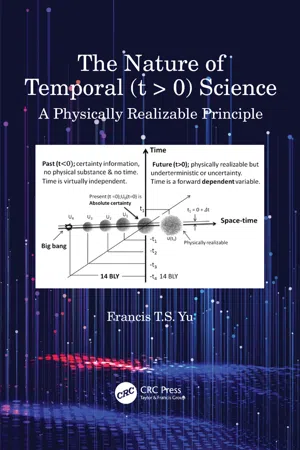Physics
Spacetime
Spacetime is a fundamental concept in physics that combines the three dimensions of space with the dimension of time into a single four-dimensional continuum. It is the framework in which events occur and is described by the theory of general relativity. Spacetime is essential for understanding the behavior of objects and the propagation of light and other forms of energy in the universe.
Written by Perlego with AI-assistance
Related key terms
Related key terms
1 of 4
Related key terms
1 of 3
10 Key excerpts on "Spacetime"
- eBook - ePub
The Fourth Dimension
Enigma of Time
- Dayalanand Roy(Author)
- 2021(Publication Date)
- BrownWalker Press(Publisher)
43The Concept of Time in Physics
What is the idea of time in physics? According to Einstein, the time of an event is the reading given by a clock placed near the event whose construction is similar to other clocks. “… A time value is associated with every event which is essentially capable of observation,”44 suggests Einstein. However, the concept of time in physics has multiple feathers in its cap. H. Dieter Zeh has thoroughly described various physical aspects of time in his work, The Physical Basis of the Direction of Time .45Though the above definition serves well the purpose of defining the ‘time’ of an event as recorded by a physicist, yet it may not satisfy the curiosity of a common man when he asks- “What do we mean by the ‘time’ being recorded by a clock?” and we answer- “Time is what a clock reads”. To me, this seems to be a circular argument. This is just like the argument that when asked what length is, we reply length is what a meter rod measures. And what does a meter rod measure? It measures length. No one will agree that length is properly explained from this argument. A better explanation is- length is one of the spatial dimensions of an object.Physics gives another description of time- ‘time is the fourth dimension of space’. It was further developed and modified by Einstein when he gave his Special Theory of Relativity- he fused this fourth dimension with the other three dimensions of space.However, when a common man hears that time is the fourth dimension of space, he is again perplexed by this idea. He can imagine, though roughly, what space is. When he looks towards sky, he thinks he is looking at space. He thinks that whatever he sees around him is located in this space. But where in space is this fourth dimension- the dimension of time? We have seen above that though initially Einstein believed in the independent existence of space, after bringing his grand General Theory of Relativity, his concept was modified. “… Space-time does not claim existence on its own, but only as a structural quality of field”40 - eBook - ePub
The Biggest Ideas in the Universe 1
Space, Time and Motion
- Sean Carroll(Author)
- 2022(Publication Date)
- Oneworld Publications(Publisher)
SIXSpacetime
In Newtonian physics, you would have been welcome to consider space and time together as a single four-dimensional Spacetime in which events are located. But nothing would have forced you to do that; space and time had their independent identities, and nobody ever got them mixed up. It was with the theory of relativity, put together in the early twentieth century, that talking about Spacetime became almost unavoidable. In relativity, it’s no longer true that space and time have separate, objective meanings. What really exists is Spacetime, and our slicing it up into space and time is merely a useful human convention.One of the major reasons why relativity has a reputation for being difficult to understand is that all of our intuitions train us to think of space and time as separate things. We experience objects as having extent in “space,” and that seems like a pretty objective fact. Ultimately it suffices for us because we generally travel through space at velocities far less than the speed of light, so pre-relativistic physics works pretty well.But this mismatch between intuition and theory does make the leap to a Spacetime perspective somewhat intimidating. To make things worse, presentations of relativity often take a bottom-up approach, starting with our everyday conceptions of space and time and seeing how they become altered in the new context of relativity. We are told stories of stretching rods and distorted clocks, all of which are technically accurate but can obscure the beauty and simplicity of the underlying concepts.We’re going to be a little different. Our route into special relativity might be thought of as top-down, taking the idea of a unified Spacetime seriously from the get-go and seeing what that implies, rather than starting from more familiar-seeming notions and seeing how they become modified in this new context. We’ll have to stretch our brains a bit, but the result will be a much deeper understanding of the relativistic perspective on our universe. - eBook - ePub
- Jim Al-Khalili(Author)
- 2020(Publication Date)
- Princeton University Press(Publisher)
CHAPTER 3 SPACE AND TIME In such a short book I am unable to cover all areas of physics, fascinating though so many of them are. Instead, I have distilled our current understanding of the physical universe down to three central pillars: three pictures of reality that come from very different directions. The first of these, introduced in this chapter and the next, is built on the work of Albert Einstein in the early twentieth century. It lays out our present understanding of the way matter and energy behave within space and time on the very largest scales due to the influence of gravity—an understanding that is encompassed in his famous general theory of relativity. In order to paint Einstein’s picture of the world, we must start with the canvas itself. Space and time are the substrates in which all events take place. However, such concepts are slippery. Common sense tells us that space and time should be in place from the start—that space is where events happen and the laws of physics are acted out, while the inexorable passage of time is, well, just is. But, is our commonsense view of space and time right? An important lesson physicists must learn is to not always trust common sense. After all, common sense tells us that the Earth is flat, but even the Ancient Greeks understood that its sheer size meant we could not easily discern its curvature, but that there were simple experiments they could perform to prove that it was in fact a sphere. Similarly, everyday experience tells us that light has the properties of a wave and therefore cannot also behave as though it were made up of a stream of individual particles. If it were, how could we explain interference patterns? And yet it has been proven beyond doubt, through careful experiments, that our senses can deceive us when it comes to the nature of light - eBook - ePub
Einstein Relatively Simple
Our Universe Revealed in Everyday Language
- Ira Mark Egdall(Author)
- 2014(Publication Date)
- WSPC(Publisher)
Minkowski declared that Einstein’s theory of special relativity is best visualized in a four-dimensional “space-time” continuum. What are these four dimensions? They are the three space dimensions ( up-down, left-right, and forward-back) and the time dimension. Minkowski proposed the revolutionary idea that time and space are not separate entities, but joined together mathematically.Minkowski proposed his concept as an alternate to Einstein’s theory rather than as a mathematical adjustment. Einstein was not amused. Minkowski’s paper contained a single physical prediction. Einstein was quick to point out it “failed to account for a known phenomenon.”a , 11Minkowski in turn had said of Einstein; “The mathematical education of the young physicist [Albert Einstein] was not very solid, which I am in a good position to evaluate since he obtained it from me in Zurich some time ago.”12 The rivalry between Einstein and Minkowski “was carried on at a level that few recognized.”13 The unpleasantness ended with Minkowski’s premature death of appendicitis in 1909 — he was 44 years old.WherewhenWhat exactly does the term Spacetime mean? To help visualize this, let’s first look at a plot of length versus width (Fig. 8.2(a)). Here the area between the two axes represents space.Now let’s construct a Spacetime diagram (Fig. 8.2(b)). What is a Spacetime diagram? It is simply a plot where one axis is time and the other axes are space. (We only plot one of the three space dimension here for simplicity.) So space is the horizontal axis and time is the vertical axis. What does the area between the axes of space and time represent? It represents Spacetime.14Are we in Spacetime right now? Yes, most definitely. But our common way of thinking is not conducive to the unification of space and time. We have to think differently — not in terms of places in space or happenings in time — but in terms of events which have a location in both space and time, i.e., in Spacetime.Strictly speaking, an event is something that occurs at a single point in space and at a single point in time. Thus an event is a single point in Spacetime. In addition, the very language we use to talk about events needs modification. For example, if you are asked where you were born, you reply with a location in space, such as in San Diego, California. If you are asked when - eBook - ePub
Something Deeply Hidden
Quantum Worlds and the Emergence of Spacetime
- Sean Carroll(Author)
- 2019(Publication Date)
- Oneworld Publications(Publisher)
general relativity, his theory of gravity and curved Spacetime. The crucial insight was that four-dimensional Spacetime isn’t just a static background on which the interesting parts of physics take place; it has a life of its own. Spacetime can bend and warp, and does so in response to the presence of matter and energy. We grow up learning about the flat geometry described by Euclid, in which initially parallel lines remain parallel forever and the angles inside a triangle always add up to 180 degrees. Spacetime, Einstein realized, has a non-Euclidean geometry, in which these venerable facts are no longer the case. Initially parallel rays of light, for example, can be focused together while moving through empty space. The effects of this warping of geometry are what we recognize as “gravity.” General relativity came with numerous mind-stretching consequences, such as the expansion of the universe and the existence of black holes, though it has taken physicists a long time to appreciate what those consequences are.Special relativity is a framework, but general relativity is a specific theory. Just like Newton’s laws govern the evolution of a classical system or the Schrödinger equation governs the evolution of a quantum wave function, Einstein derived an equation that governs the curvature of Spacetime. As with Schrödinger’s equation, it’s fun to actually see Einstein’s equation written out, even if we don’t bother with all the details:Rμν —(½)Rgμν = 8πGTμνThe maths behind Einstein’s equation is formidable, but the basic idea is simple, and was pithily summarized by John Wheeler: matter tells Spacetime how to curve, and Spacetime tells matter how to move. The left-hand side measures the curvature of Spacetime, while the right-hand side characterizes energy-like quantities, including momentum, pressure, and mass.General relativity is classical. The geometry of Spacetime is unique, evolves deterministically, and can in principle be measured to arbitrary precision without disturbing it. Once quantum mechanics came along, it was perfectly natural to try to “quantize” general relativity, obtaining a quantum theory of gravity. Easier said than done. What makes relativity special is that it’s a theory of Spacetime rather than a theory of stuff within Spacetime. Other quantum theories describe wave functions that assign probabilities to observing things at definite, well-defined locations in space and moments in time. Quantum gravity, by contrast, will have to be a quantum theory of Spacetime itself. That raises some issues. - James Luscombe(Author)
- 2018(Publication Date)
- CRC Press(Publisher)
Chapter 1Relativity A theory of space, time, and gravityR elativity is a theory of space and time that provides the foundation for much of physics. It applies to any branch of physics that makes use of the four variables x , y , z , t , where x , y , z are independent spatial coordinates and t denotes time.1 While originating from a reasonable premise (see below), the theory of relativity2 implies conceptions of space, time, matter, and motion vastly different from what our everyday experience of the world leads us to formulate. To understand physics in full, as applied to phenomena beyond ordinary experience, one must study relativity (as well as quantum mechanics); our everyday experience is but a special case of all that’s possible in the universe. We’ll see that relativity consists of two theories: the special theory of relativity (SR) and the general theory of relativity (GR).1.1The principle of relativity to vanquish coordinates, transcend themIn broadest terms, relativity holds that the universe doesn’t care what systems of coordinates, or reference frames we use to describe physical phenomena.3 Such a statement hardly sounds revolutionary, yet its implications are far-reaching because in the theory of relativity time is taken as a coordinate in a four-dimensional geometry of space and time, rather than as a parameter in pre-relativistic physics.4 Coordinates are essential for making measurements and performing calculations, yet they’re not fundamental—they don’t exist in nature—they’re artifacts of our thinking , what we as humans impose on the world. Therein lies the rub. We need coordinates for practical purposes, yet the goal of physics is to formulate laws of nature as manifestations of an objective reality, that which occurs independently of human beings.5 The laws of physics should be expressed in a way that’s independent of coordinate system . Relativity is an outgrowth of a single idea, the principle of relativity , that physical laws be independent of the reference frame used to represent them. Relativity is therefore a law about laws .6 Albert Einstein said: “… time and space are modes by which we think, and not conditions in which we live.”[2, p81] The program of relativity is to express equations of physics in such a way that, if true in one system of space-time coordinates, are true in any coordinate system, and thereby transcend coordinates. We will travel far in the theory of relativity in pursuit of this goal, which, as we’ll see, is achieved by expressing equations as relations between tensors ,7- eBook - ePub
- Michael V Berry(Author)
- 2017(Publication Date)
- CRC Press(Publisher)
4 Curved Spacetime and the physical mathematics of general relativity 4.1 Particle paths and the separation between events Now we must start to get to grips with general relativity itself. We wish to predict the motion of a body under the action of gravitation, avoiding the difficulties already described which result from the Newtonian formalism. Therefore we employ a Spacetime description, and seek the world line of the body, that is, the locus of successive events in its history. Each event is a point in Spacetime, specified by four coordinates x i, where i = 0, 1, 2, 3. It is conventional to take x 0 as a time coordinate t, and x 1, x 2 and x 3 as three coordinates giving the spatial position r (= x, y, z; r, θ, ϕ etc.). We have in mind here a lattice formed by rigid ‘standard rods’. whose intersections give spatial positions; at each intersection is a ‘standard clock’which can be synchronised with all the others by means of a technique involving light signals – it is not necessary for us to go into details here. For any event, the nearest intersection gives r, and the clock reading there gives t. However, much more general specifications of events can be employed. For example, an explosion in the atmosphere can be specified by taking the readings of clocks carried by four randomly-moving aeroplanes, at the moment the explosion is seen or heard; the clocks need not be synchronised and may even run at different speeds, but they must keep going. The four readings thus obtained specify the explosion event uniquely, and form a perfectly acceptable set of coordinates x i. This freedom in choosing coordinate systems is particularly useful in view of the fact that a rigid body, such as a ‘standard rod’, is not easy to define in relativity (the trouble arises because the speed of sound in such a body would be infinite, and therefore greater than that of light) - eBook - ePub
Graphic Guides
A Graphic Guide
- Bruce Bassett, Ralph Edney(Authors)
- 2014(Publication Date)
- Icon Books(Publisher)
HOW COULD WE MAKE A SPACE WHICH WOULD ALLOW US TO RECORD THE POSITION OF EVERY SINGLE ATOM AT EVERY MOMENT IN THE UNIVERSE’S HISTORY?SO EACH ATOM REQUIRES ITS OWN 4-DIMENSIONAL SPACE...WELL, FOR EACH ATOM WE NEED FOUR NUMBERS, ITS POSITION IN SPACE – THERE NUMBERS – AND ITS TIME – ONE NUMBER...... YES, AND 5 ATOMS REQUIRE A 4×5 = 20-DIMENSIONAL SPACESlicing Spacetime
However, we have an infinite number of atoms in this example, so the complete space is infinite dimensional (4 × infinity = infinity). We need an infinite number of numbers to record uniquely where all the atoms are. This space, though we will not need it, is known as configuration space in mechanics, since it gives the configuration of the system.Notice that by thinking of spaces abstractly, one gives up the need to be able to visualize them in everyday terms.A POWERFUL WAY IS TO CONSIDER “SLICES” OF THEMBUT IT IS OFTEN USEFUL TO TRY TO VISUALIZE THEMWe can slice up Spacetime (which is four-dimensional) into three-dimensional slices which we can visualize.How to View Spacetime
One of the big advantages of abstraction by letting go of the need to visualize things as they would look in our world is that we can give up the urge to think continually of spaces in terms of them being inside bigger spaces.FOR EXAMPLE, WE TYPICALLY THINK OF A SHEET OF PAPER AS A TWO-DIMENSIONAL SPACE LYING IN OUR THREE-DIMENSIONAL SPACESO WHEN PEOPLE HEAR THAT THE UNIVERSE IS EXPANDING, THEY NATURALLY ASK...... EXPANDING INTO WHAT?This is a natural question, from the standard point of view, but not from our new view in which we think of a space as existing completely separately from any other space. Hence, cosmologists usually think of the expansion of the universe only as a property of Spacetime itself, namely that the distance between any points IN THE Spacetime is increasing.Simultaneity is Relative
One of the key ingredients of relativity is that – unlike Newton’s view of gravity – space and time are unified into a four-dimensional space which can be sliced, like a loaf of bread, in different ways, to give “space” and “time”. But there is NO UNIQUE or preferred way to slice Spacetime. This is in fact a geometrical - eBook - ePub
- Malcolm Torry(Author)
- 2023(Publication Date)
- Resource Publications(Publisher)
But there are some extreme phenomena that his theories cannot explain, which is why further theories are now being proposed: and just as Newton’s theories were found to be an approximation of Einstein’s under certain restricted conditions, if further theories begin to establish themselves—that is, if they are found to be explanatory and predictive—then we are likely to find that Einstein’s theories would function as approximations under certain conditions. And so, for instance, a case has been made for understanding space-time as “momentum space.” After all, it is momentum that we experience. We experience light hitting our retinas, and electron microscopes measure the momentum of particle debris. A further four dimensions would be added to the four traditional space-time dimensions: energy, and three dimensions of momentum: and it has been found that in momentum space space-time measurement becomes flexible and related to the position of the observer. This is similar to relativity: although in Einstein’s theories it is space and time that are relative to each other within a stable space-time. In momentum space, no longer is space-time a stable framework for reality, although it approximates to one under the conditions that we normally experience. And perhaps momentum space is an approximation to some deeper level framework, and so on. 469 Beyond space, time, momentum, and energy, what is there? There is action in patterns: and there is no reason in logic why the layers of patterning should not go on and on, and no reason why the action and the diversity of changing patterns of action should not in principle be infinite. And so there is time, space, energy, momentum, mass, light, gravity, and much more: these are all action in changing patterns, and they are all related to each other - eBook - ePub
The Nature of Temporal (t > 0) Science
A Physically Realizable Principle
- Francis T.S. Yu(Author)
- 2022(Publication Date)
- CRC Press(Publisher)
One of the esoteric features of Einstein's general theory is curving the time-space [3]; as John Wheeler had said: Space-time tells matter how to move; matter tells space-time how to curve. However, as I see it, it is time tells space how to curve but space does not tell time how to curve. In this I mean that it is time changes time-space, but not time-space that changes the time. The general theory was developed based on a Minkowski's space-time continuum where time is treated as an independent variable. However, from temporal (t > 0) universe standpoint, time and space coexist for which time is a dependent forward moving variable that moves at a constant pace. In other words, within our temporal universe, it is time that changes time-space, but not time-space curves the pace of time.As we have accepted the origin of our universe was started from a big bang explosion within a temporal (t > 0) space [1,2], instead the creation within an empty space as normally assumed [10]. Then before big bang started a question may be asked: what triggered the explosion? As I had shown, it must be ignited by an intense convergent gravitational force created by a gigantic mass M(t) that eventually triggers the thermo-nuclei explosion. By this a question inquires under what physical condition will ignite the big band explosion. Since science is a law of approximation, I would assert that it must come from an extreme convergent gravitational force that had been induced by a temporal mass M(t), as shown in Figure 5.12 ..Figure 5.12Shows a scenario well before the big bang explosion. Dark dot represents a point-singularity approximated gigantic temporal (t > 0) mass M(t), F(t) represents a huge gravitational field created by M(t), the arrows show a set of very intense convergent gravitational forces are applying on a mass M(t)In this we see that M(t) had been situated within a temporal (t > 0) space before the big bang started. Since temporal (t > 0) space is non-empty, it allows M(t) to create (i.e., store) its gravitational field (i.e., energy) induced by the existence of M(t). From this M(t) is capable of continually attracting substances added into its mass. In other words, M(t) behaves like a giant black hole (or it is a black hole) [11] that is constantly swallowing more and more substances. Over time, M(t) is getting heavier and heavier until its stored gravitational force reaches to a critical point that triggers the thermo-nuclei explosion of M(t). From this we see that big bang explosion must be ignited by huge gravitational pressure, instead of triggered by time as most cosmologists had assumed. For this big bang explosion must be due to extreme gravitational pressure of its own induced gravitational field that triggers the thermo-nuclei explosion of mass M(t), at least from our current physical standpoint. Nevertheless, it is the preexisting temporal (t > 0) space paradigm that provides all the possible temporal (t > 0) substances to continuously feed M(t) for the eventuality of self-explosion by its own weight. In other words, without the preexistent temporal (t > 0) space paradigm, we would not have a justifiable scientific reason that big bang theory had occurred. This is one of the many examples that show that a physically realizable solution comes from a physically realizable paradigm. Of this we see that big bang creation cannot get started within an empty space, as many cosmologists had assumed it was.
Index pages curate the most relevant extracts from our library of academic textbooks. They’ve been created using an in-house natural language model (NLM), each adding context and meaning to key research topics.
Explore more topic indexes
Explore more topic indexes
1 of 6
Explore more topic indexes
1 of 4
